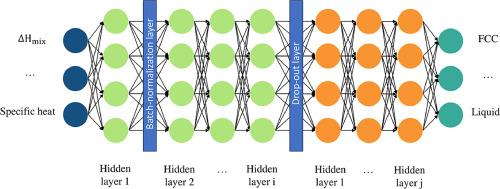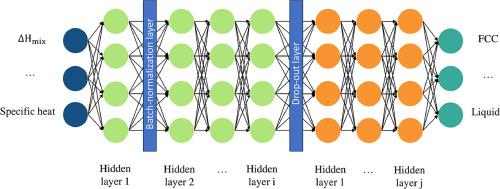Deep learning accelerated phase prediction of refractory multi-principal element alloys
IF 8.3
1区 材料科学
Q1 MATERIALS SCIENCE, MULTIDISCIPLINARY
引用次数: 0
Abstract
The tunability of the mechanical properties of refractory multi-principal-element alloys (RMPEAs) makes them attractive for numerous high-temperature applications. It is well-established that the phase stability of RMPEAs controls their mechanical properties. In this study, we develop a deep learning framework that is trained on a CALPHAD-derived database and is predictive of RMPEA phases with high accuracy up to eight phases within the elemental space of Ti, Fe, Al, V, Ni, Nb, and Zr with an accuracy of approximately 90 %. We further investigate the causes for the low out-of-domain performance of the deep learning models in predicting phases of RMPEAs with new elemental sets and propose a strategy to mitigate this performance shortfall. While our proposed approach shows marginal improvement in accurately predicting the phases of RMPEAs with new elemental sets, we should emphasize that overcoming the out-of-domain problem remains largely challenging, particularly in materials science where there are missing elements or absent material classes in training data hindering predictions, thus slowing the discovery of new potential materials. Predicting phase competition is inherently difficult due to the very small differences in free energies (on the order of meV/atom) that govern competing phases. Current deep learning models, including ours, face significant limitations in capturing these subtle energy differences. Accordingly, more substantial future work is needed to fully address this challenge and achieve robust out-of-domain predictions in complex alloy systems.


深度学习加速难熔多元素合金的相位预测
难熔多元素合金(RMPEAs)机械性能的可调性使其在众多高温应用中具有吸引力。RMPEAs 的相稳定性控制着它们的机械性能,这一点已得到公认。在本研究中,我们开发了一种深度学习框架,该框架在 CALPHAD 衍生的数据库上进行训练,可高精度预测 RMPEA 相,在 Ti、Fe、Al、V、Ni、Nb 和 Zr 元素空间内可预测多达八个相,准确率约为 90%。我们进一步研究了深度学习模型在预测具有新元素集的 RMPEA 相位时域外性能较低的原因,并提出了缓解这种性能不足的策略。虽然我们提出的方法在准确预测具有新元素集的 RMPEAs 相方面显示出边际改进,但我们应该强调的是,克服域外问题在很大程度上仍然具有挑战性,尤其是在材料科学领域,训练数据中缺失的元素或不存在的材料类别会阻碍预测,从而减缓发现新的潜在材料的速度。由于支配竞争相的自由能差异非常小(约为 meV/原子),预测相竞争本身就很困难。目前的深度学习模型,包括我们的模型,在捕捉这些微妙的能量差异方面面临着很大的局限性。因此,未来需要开展更多实质性工作,以全面应对这一挑战,并在复杂合金系统中实现稳健的域外预测。
本文章由计算机程序翻译,如有差异,请以英文原文为准。
求助全文
约1分钟内获得全文
求助全文
来源期刊

Acta Materialia
工程技术-材料科学:综合
CiteScore
16.10
自引率
8.50%
发文量
801
审稿时长
53 days
期刊介绍:
Acta Materialia serves as a platform for publishing full-length, original papers and commissioned overviews that contribute to a profound understanding of the correlation between the processing, structure, and properties of inorganic materials. The journal seeks papers with high impact potential or those that significantly propel the field forward. The scope includes the atomic and molecular arrangements, chemical and electronic structures, and microstructure of materials, focusing on their mechanical or functional behavior across all length scales, including nanostructures.
 求助内容:
求助内容: 应助结果提醒方式:
应助结果提醒方式:


